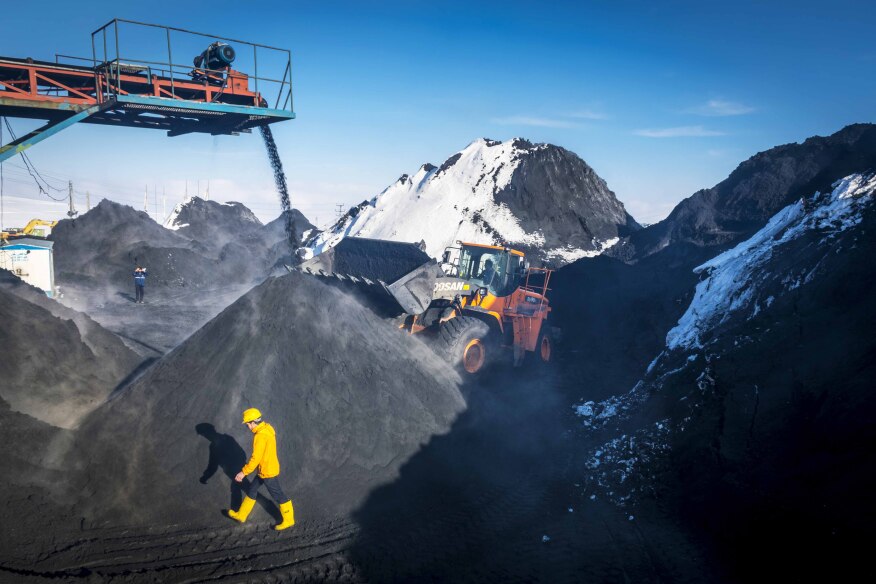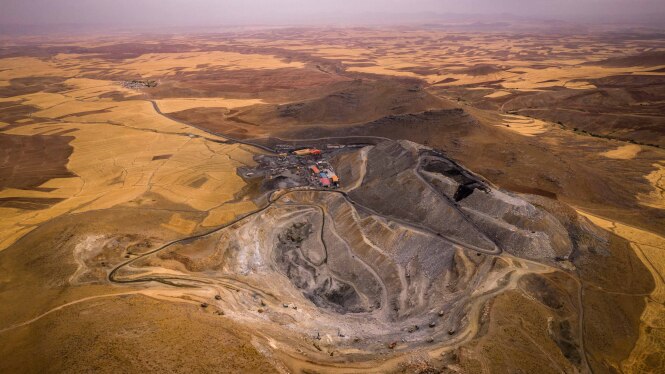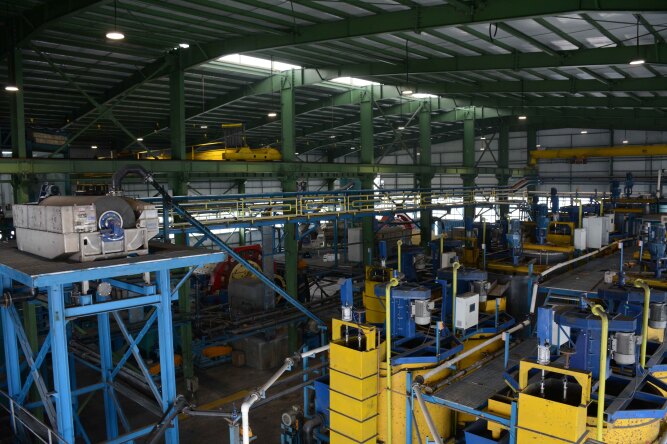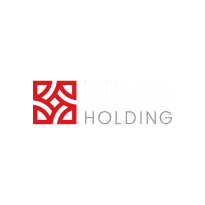Exploring the Process and Importance of Mining Iron Concentrate

Mining of iron concentrate plays a crucial role in various industries worldwide, serving as a fundamental component in the production of steel and other essential materials. This article aims to provide an in-depth exploration of the mining process involved in extracting iron concentrate and discusses the environmental and economic considerations associated with this process. Emphasizing the necessity for sustainable practices, the article highlights the impacts such as habitat destruction, pollution, and resource depletion and underscores the importance of stringent regulations and responsible resource stewardship. By understanding these processes and their significance, the article aims to shed light on the critical role of iron concentrate in driving industrial competitiveness and economic development while promoting a sustainable future. Through examining the technical aspects of mining, including exploration, extraction and processing, the discussion also addresses the balance between the high productivity and the environmental footprint of open-pit mining methods, as practiced at Kimia Mines Company. Overall, the insights provided aim to foster a comprehensive understanding of the vital intersection between mining activities and their broader implications for both the environment and the global economy.
Understanding Iron Concentrate Mining
Iron concentrate, also known as iron ore concentrate, is a fine powdery substance obtained from the beneficiation of mined iron ore and primarily composed of iron oxides, with varying levels of impurities such as silica, alumina, and phosphorus, depending on the ore source and processing techniques employed. The mining process typically includes several stages such as exploration, exploitation, processing and transportation. Exploration involves comprehensive geological assessments to identify potential ore deposits using techniques like remote sensing and drilling. Exploitation methods, including open-pit mining, underground mining and dredging, are chosen based on factors like ore depth and geological conditions. The processing stage enhances the iron content through crushing, grinding, and separation techniques, producing high-quality iron concentrate essential for steel manufacturing.
Exploration
Exploration serves as the initial phase of any mining operation, involving comprehensive geological assessments to identify prospective areas for mineral deposits, including iron ore. This critical stage aims to gather detailed information about the geology of a potential mining site to assess the presence, size, grade and economic value of the mineral deposits. Geologists employ a range of advanced techniques to achieve this, including remote sensing, geological mapping, geophysical surveys and drilling. Remote sensing involves the use of satellite imagery and aerial photography to detect surface anomalies that may indicate underlying mineral deposits. Geological mapping helps in understanding the surface and subsurface geological formations, while geophysical surveys, such as magnetic, gravity, and seismic methods, provide data on the physical properties of the rocks and their distribution. Drilling, particularly core drilling, is used to obtain direct samples from beneath the surface, allowing for detailed analysis of the ore body’s characteristics.
The geological data acquired during exploration are pivotal in providing crucial insights into the composition, structure and distribution of the ore body. These insights guide subsequent extraction efforts by determining the most suitable exploitation methods and mining techniques. For instance, the choice between open-pit and underground mining largely depends on the depth and geometry of the ore body. Furthermore, the data help in designing the necessary infrastructure, such as access roads, processing plants and waste disposal facilities, optimizing operational efficiency and resource utilization. Environmental impact assessments are also conducted during this phase to ensure that mining activities comply with regulatory requirements and minimize ecological disruption.
In the context of iron ore mining, the exploration phase is particularly critical due to the extensive scale and economic significance of iron ore deposits. Iron ore exploration involves detailed analysis to determine the ore’s iron content (Fe grade), the presence of impurities, and the overall feasibility of mining the deposit. The results from exploration activities help in creating a robust mine plan that maximizes ore recovery while minimizing costs and environmental impacts. By understanding the precise characteristics of the iron ore body, mining operations can implement targeted extraction techniques that enhance productivity and ensure the sustainable development of the resource. Thus, effective exploration not only lays the foundation for successful mining operations but also plays a crucial role in the long-term viability and environmental stewardship of iron ore mines.
1. Surface Mining
Surface mining is a widely used method for extracting shallow ore deposits, particularly those located near the surface. This method involves the excavation of large open pits or quarries using heavy earth-moving equipment such as excavators, bulldozers and haul trucks. Overburden, the soil and rock covering the ore body, is removed to expose the ore, which is then extracted and transported to the processing plant for beneficiation.
There are several types of surface mining methods, including open-pit, quarry, strip mining and auger mining. Each method has its specific applications and is chosen based on the depth and geometry of the ore body, as well as economic and environmental considerations. For instance, open-pit and quarry methods are ideal for extracting ore bodies near the surface, while strip mining is used for horizontal ore bodies, and auger mining is employed when the ore is too deep for surface mining but too shallow for underground mining.
Generally open-pit mining (as we practice it at Kimia Mines Company) is favored for its cost-effectiveness and high production rates, making it suitable for large-scale operations. This mining technique involves removing surface layers to access ore deposits beneath, allowing for the extraction of vast quantities of minerals in a relatively short period and many mining companies prefer this method for its ability to maximize output and profitability. However, it can have significant environmental impacts, including habitat disruption, soil erosion and visual intrusion. The process of removing overburden and extracting ore leads to the destruction of local flora and fauna habitats, significantly altering ecosystems. Soil erosion can result from the removal of vegetation, leading to sedimentation in nearby water bodies and adversely affecting aquatic life. Additionally, the large scars on the landscape from open pits are often visible from great distances, impacting the aesthetic value of natural landscapes and potentially affecting tourism and local communities' quality of life.
To mitigate these environmental impacts, careful planning, rehabilitation measures, and environmental monitoring are essential. Effective planning involves conducting thorough environmental impact assessments before commencing mining operations to identify potential adverse effects and develop strategies to address them. Rehabilitation measures include restoring the mined land to its natural state or repurposing it for other uses, such as recreational areas or wildlife habitats. This process often involves backfilling open pits, replanting vegetation, and ensuring that water quality is maintained. Continuous environmental monitoring throughout the mining operation ensures compliance with environmental regulations and helps in adapting mitigation strategies as needed. By implementing these practices, companies can minimize the environmental footprint of open-pit mining and promote sustainable resource extraction.
2. Underground Mining
The advantages of surface mining include access to abundant resources, increased safety compared to underground mining, lower costs, reduced environmental impact during operation, and higher efficiency due to the use of larger equipment. However, disadvantages include habitat destruction, water and air pollution, safety hazards, and long-term environmental impacts such as soil erosion and the difficulty of restoring natural ecosystems after mining activities cease.
In the context of iron ore mining, surface mining, particularly open-pit mining, is commonly employed due to the typically extensive and shallow nature of iron ore deposits. This process involves drilling, blasting, and hauling the ore to processing facilities where it is crushed and screened. The extracted iron ore is then subjected to beneficiation processes to increase its iron content and remove impurities, preparing it for subsequent use in steel production. Effective management and rehabilitation strategies are crucial for maximizing ore recovery, mitigate environmental impacts and ensure the sustainability of mining operations.
For ore deposits located at greater depths or in challenging geological conditions, underground mining techniques are employed. This method involves accessing the ore body through tunnels or shafts and extracting the ore using specialized mining equipment and techniques. There are several methods of underground mining, such as room and pillar, longwall, cut and fill, sublevel stopping, and block caving.
Room and pillar mining involves creating a network of rooms separated by pillars of ore to provide structural support. While safer and cost-effective, this method can leave behind a significant amount of ore to maintain stability. In contrast, longwall mining utilizes a shearer to cut ore along a coal face, supported by hydraulic systems to control roof collapse as it progresses. Cut and fill mining, suitable for steeply dipping ore bodies, involves cutting ore and filling the space with waste material to create a working platform. It allows for high recovery rates but is costly due to backfilling requirements. Sublevel stopping includes drilling and blasting ore from sublevels within the ore body, enabling efficient extraction from large, steep ore deposits. Block caving, applicable to large, deep ore bodies, involves undermining the ore body to induce controlled collapse under its own weight. It is cost-effective for low-grade ores but demands substantial initial investment and careful monitoring.
Underground mining has the advantage of causing minimal surface disturbance and accessing higher ore grades. However, it presents challenges such as ensuring safety, providing adequate ventilation and maintaining access to deep ore bodies. It requires meticulous planning and engineering to mitigate risks, worker's safety and ensure efficient operation.
In the context of iron ore, underground mining is employed when surface mining is impractical due to depth or geological constraints. Techniques like sublevel stopping and block caving are often preferred for their efficiency in extracting large volumes of ore with minimal surface impact. These methods, combined with careful planning and technological advancements, help optimize the extraction process while minimizing environmental footprint and ensuring safety.
Exploitation
Once a viable ore deposit is identified, extraction operations commence, marking the transition from exploration to active mining. This phase involves removing the ore from the earth and is influenced by various factors such as the depth and geometry of the ore body, ore grade, geological conditions, environmental considerations and economic viability. Generally, exploitation methods can be categorized into surface mining and underground mining. Surface mining is used for shallow, extensive ore bodies and involves removing the overburden to expose the ore. It is efficient for large, low-grade deposits. Underground mining, chosen for deeper ore bodies, involves creating tunnels or shafts to access the ore and is used when the ore is too deep for surface mining. Each method is selected based on the ore's location and environmental impact.
Special circumstances arise in mining when deposits are located underwater, such as in coastal or offshore environments. In these situations, dredging (Marine Mining) techniques are commonly employed for extraction. Dredging utilizes specialized vessels equipped with suction devices or mechanical dredges to remove sediments and extract ore from the seabed. Marine mining presents significant challenges related to environmental impact, habitat disturbance and navigational safety. Therefore, it necessitates rigorous regulatory frameworks and comprehensive environmental monitoring to mitigate potential risks and ensure sustainable operations.

Overview of the Open-pit Iron Ore Mine & Waste Dump of Kimia Mines Company
WE ARE KIMIA
Kimia Holding stands as a diversified conglomerate with a strong foothold in various sectors including mining and mineral resources, tourism services, livestock and poultry, agriculture, and foreign trade foreign trade in Iran and across the Middle East. However, it is within the realm of mining that Kimia Holding has truly distinguished itself, garnering recognition for its unwavering commitment to excellence and innovation.
CONTACT KIMIA
Our experts at Kimia Holding eagerly await your inquiries and are prepared to provide insightful answers or address any questions you may have. Should you require further details or wish to share your opinions, please don't hesitate to reach out. Your engagement is valuable to us.
Following the extraction phase, the raw ore undergoes a crucial processing steps designed to refine its composition and produce iron concentrate. Initially, the ore is crushed into smaller particles to facilitate subsequent processing. This is followed by grinding to achieve finer granularity, essential for effective separation of iron minerals from gangue minerals through techniques such as magnetic separation, flotation or gravity separation. Magnetic separation utilizes magnetic properties to separate iron minerals from non-magnetic gangue minerals. Flotation exploits differences in surface chemistry between iron minerals and gangue minerals to selectively separate them. Gravity separation utilizes the difference in density between iron minerals and gangue minerals to achieve separation. These methods concentrate the iron content while reducing impurities, thereby significantly enhancing the purity and commercial value of the final product. Advanced techniques such as high-intensity magnetic separation and column flotation are increasingly being adopted to further improve efficiency and recovery rates, ensuring the iron concentrate meets stringent industrial standards.
Processing and Beneficiation
Iron concentrate undergoes transformation through the blast furnace and Basic Oxygen Furnace (BOF) processes, which are integral to steel production. In a blast furnace, the iron concentrate is combined with coke and limestone and subjected to high temperatures to produce molten iron. This molten iron, or pig iron, is then refined in the BOF process, where it is converted into molten steel. These processes allow for the efficient extraction and refinement of iron, facilitating the production of high-quality steel. Additionally, these methods enable the incorporation of various elements, such as carbon and other metals, to produce different steel grades, each tailored to specific industrial requirements.
3. Alloying and Customization
2. Blast Furnace and Basic Oxygen Furnace (BOF) Processes:
Iron concentrate plays a pivotal role in the alloying and customization of steel properties. Alloying involves the addition of other elements to molten steel to enhance its properties, such as strength, ductility, and resistance to corrosion. This customization is essential for producing specialized steels used in various applications. For instance, in the automotive industry, high-strength, low-alloy steels are crucial for manufacturing lightweight and fuel-efficient vehicles. In the construction sector, different steel grades are used to build structures that can withstand diverse environmental conditions. The ability to tailor steel properties through alloying makes iron concentrate indispensable in meeting the specific needs of various industries.
Significance in Steel Production
Iron concentrate serves as the cornerstone of steel production, underpinning numerous industries and infrastructure projects worldwide. Its importance can be categorized in the following:
Iron concentrate, being the primary source of iron, forms the essential basis for steel production. The high iron content in the concentrate makes it ideal for smelting processes, providing the necessary purity and quantity of iron required for steelmaking. Steel, renowned for its strength and versatility, relies heavily on this raw material to meet the rigorous demands of various industries. The purity and consistency of iron concentrate ensure that the steel produced meets specific quality standards, which is crucial for its application in critical sectors such as construction, automotive, and manufacturing.
1. Raw Material for Steel Production
4. Versatility and Ubiquity
Steel’s widespread use in various products and applications underscores the indispensability of iron concentrate. From skyscrapers and bridges to household appliances and machinery, steel’s versatility stems from its ability to be molded into various shapes and sizes, with properties that can be precisely controlled through metallurgical processes. This adaptability drives economic development and innovation, as industries continuously find new uses for steel. The reliability and performance of steel, derived from high-quality iron concentrate, ensure that it remains a fundamental material in modern society, supporting infrastructure development and technological advancement.
5. Global Supply Chains and Industrial Competitiveness
Access to reliable sources of iron concentrate is crucial for maintaining global supply chains and industrial competitiveness. The stability of steel production hinges on the consistent availability of high-quality iron concentrate. Disruptions in supply can lead to significant economic repercussions, affecting industries worldwide. Therefore, sustainable extraction practices and efficient resource management are essential to ensure a steady supply. Countries with abundant and well-managed iron ore reserves can maintain a competitive edge in the global market, fostering industrial growth and economic stability. Effective supply chain management also involves strategic partnerships and investments in mining technologies to enhance the efficiency and environmental sustainability of iron concentrate production.
Environmental & Economic Considerations
While iron concentrate mining is vital for meeting societal needs, it also presents significant environmental and economic challenges. The extraction process often leads to habitat destruction, threatening biodiversity and disrupting ecosystems. Additionally, mining operations contribute to air and water pollution through the release of particulate matter and harmful chemicals, which can have severe health impacts on nearby communities and wildlife. These environmental concerns necessitate the implementation of sustainable mining practices to minimize ecological damage and ensure the long-term viability of mining activities.
From an economic perspective, the depletion of iron ore resources poses a considerable challenge. As high-grade iron ore becomes scarcer, mining companies must invest in more advanced technologies and methods to extract lower-grade ores, which can increase operational costs. Moreover, the fluctuating global demand for steel, influenced by economic cycles, affects the profitability and stability of the mining sector. Ensuring economic sustainability requires a balance between efficient resource utilization and maintaining the economic viability of mining operations. This balance is critical for supporting the industries that rely on steel and for fostering economic growth.
To address these environmental and economic challenges, stringent regulations and responsible resource stewardship are imperative. Governments and regulatory bodies must enforce laws that promote sustainable mining practices, such as land reclamation, pollution control and the use of cleaner technologies. Collaborative efforts between policymakers, industry stakeholders and environmental organizations can lead to innovative solutions that mitigate adverse impacts, ensuring that iron concentrate mining continues to meet societal needs without compromising environmental integrity or economic stability.

View of the Processing Plant of Kimia Mines Company
Conclusion
The mining and processing of iron concentrate are integral to the production of steel and numerous other industries, contributing significantly to global economic development and industrial competitiveness. The comprehensive stages involved, from exploration to beneficiation, ensure that the iron concentrate meets the required standards for various industrial applications. While the industry faces substantial environmental and economic challenges, such as habitat destruction and resource depletion, adopting sustainable practices and stringent regulatory measures can mitigate these impacts. Effective management strategies, technological advancements and collaboration among stakeholders are essential for promoting a balance between high productivity and environmental stewardship. By addressing these challenges, the iron concentrate mining sector can continue to thrive and support sustainable industrial growth in the future.
References
1. Hudson, T. L.; Fox, F. D.; Plumlee, G. S.; Metal Mining and the Environment. American Geosciences Institute, 1999.
2. Mudd, G. M.; "The Environmental Sustainability of Mining in Australia: Key Mega-Trends and Looming Constraints", Resources Policy, 35(2), pp. 98-115, 2010.
3. Jain, R. K.; Cui, Z; Domen, J. K.; Environmental Impact of Mining and Mineral Processing: Management, Monitoring, and Auditing Strategies. Elsevier, 2016.
Written by Kimia Mines Company(KMC),
a subsidiary of Kimia Holding, began operations in 2018, focusing on mining exploration and exploitation within and outside Iran. The company specializes in producing iron concentrate, with a current capacity of 800,000 tons per year, supplying leading companies in the industry. Kimia Mines Company aims to be a leading force in advancing the country's mining sector.





